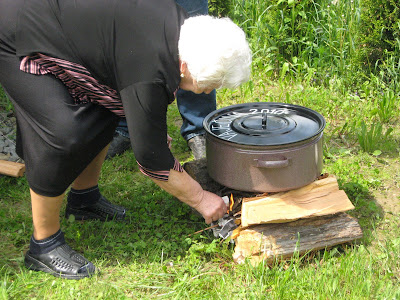Vajecina (vie cheena) means "egg festival." My Moravian relatives gather six weeks after Easter every year for a family reunion. They take turns hosting this annual event. I planned our trip so that Pam and I would be in Breznice near Zlin to enjoy their 17th annual Vajecina celebration. Every guest is required to bring a couple of eggs and a dessert. A fire is built outdoors, and the eggs are scrambled in a huge kettle over an open fire. The lid is repainted every year to show the current date. There are usually around 30 relatives in attendance. This year, over 100 eggs were contributed for the meal. The following photos capture the essence of Vajecina in Moravia.
The lid for this year's kettle
The honor of lighting the Vajecina fire goes to the oldest relative present.
My father's first cousin, Jarmila, just celebrated her
88th birthday on May 5th.
Jarmila also cracks the first egg.
Pam captured a great photo of the eggs being poured into the kettle.
Many secret ingredients are added to the scrambled egg mix.
Pam and I take our turn stirring the eggs.
A glass of wine helps us concentrate on our work.
Our friend, Jozka, is amused by the two crazy Americans.
Slavek is the life of the party.
You can't help but smile when he is around.
First he makes sure that everyone has a drink and something to eat.
Then he tells stories, which are funny even if you don't understand Czech.
Where there's smoke . . . . there's Vajecina.
Early that morning, long before the guests arrived,
I caught this deer lounging next to the shed in Jarda's backyard.
He didn't stay for Vajecina.
One of the many offerings brought by the guests.
There is a little bit of cream cheese hidden in each pastry.
Pam and I adopted this plate and kept it close by at all times.
A beautiful cake for Hana's 70th birthday.
The little round puff pastries are wedding kolaches.
The platter of meat is called Rizek, and is similar to Weiner Schnitzel.
Jarda bought this table cloth in Bangladesh,
when he was building an addition to a Skoda car factory there.
Glasses are lined up for a toast to Hana's 70th birthday.
Guests graze all day long on these delicious dishes.
The eggs are ready.
Helena prepares to serve the guests.
Jarda and one of Helena's cousins wait their turn.
That plastic bottle next to the kettle contains wine.
You can go to the winery (Vinoteka)
and have them fill a five liter plastic bottle
straight from the wine cask.
Each guest receives an open face egg sandwich on fresh rye bread.
This is what we have all been waiting for, the Vajecina sandwich.
Once you get your egg sandwich,
you walk back to the house to check out the desserts and other goodies.
My favorite Vallachian pastry, the frgala.
Basically, it is a prune and cream cheese pizza.
The best!
Jarda and Helena's daughter, Darina, and her husband, Lada.
Jarda and Helena's son, Petr, and his girlfriend, Veronika.
The day of Vajecina was Petr's 32nd birthday.
Pam and Hana
Sisters
Helena, Hana and Jarmila
Yum!
This was my third Vajecina.
In 2006, Dave and I attended Vajecina near the tiny village of Mexiko
(yes, that's in the Czech Republic).
In 2007, I took my then 89-year-old mother to Vajecina in Stara Ves (Old Village), Moravia.
I hope to attend many more Vajecinas.
These people know how to party.
Jeannette =)




















































